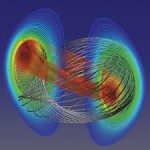Last Monday’s science class was held at the Plasma Science & Fusion Center of MIT. The purpose of the field trip was to familiarize us with concepts of plasma and its possible use in energy production. At the center we were received by two of the graduate students who are conducting research in plasma physics and magnetic fusion energy. The trip was organized in two parts where in the first 45 minutes one of the grad students Zach Hartwig gave us an overview of what the whole fuss is about regarding fusion energy, how it is achieved, why is needed, and its pros and cons. In the second half we were taken to see the actual lab where th
 e experiments take place and also introduced to the Alcator C-Mod. The Tokamak is a donut-shaped confinement device which through a magnetic system is able to control and contain the fusion plasmas.
e experiments take place and also introduced to the Alcator C-Mod. The Tokamak is a donut-shaped confinement device which through a magnetic system is able to control and contain the fusion plasmas.
What is plasma?
Even though it was only discovered, or rather scientifically articulated, in 1879 by Sir William Crookes, plasma “compromises almost all the visible matter in the universe, approximately ~ 99%.” Plasma is considered to be the fourth phase of the matter. We all are familiar with the first three: solids, liquids, gases. To be taken in consideration is the temperature, or energy, which is essentially what makes the matter float through these phases. The higher we raise the temperature the higher the speed of the molecules in the matter and the greater their distance, which generally brings less density as we move from solids to plasma. The general public is progressively becoming more accustomed with plasma even as a term through many of its current uses. Plasma TVs are some of the most known, despite the fact that “plasma etching forms the backbone of the $250 billion semiconductor processing industry, or that plasmas are used in powerful, energy sufficient propulsion thrusters for small spacecraft.” 
Another revolutionary use of plasma is in the lighting industry like the compact fluorescent bulbs (CFC).
We measure plasma’s temperature in terms of eV (electron-volt). How does this compare with the most common temperature units that we are familiar with?
![]()
We now know Plasma…. So how does Energy come in?
The nucleus of an atom consists of protons and neutron which are bounded together by a very strong nuclear force. The mass
of the atom is more depended on the weight of the nucleus than that of the electrons, and according to Einstein’s formula of Energy E = m*c2 we can derive that mass converts into energy as well. There are two major types of extracting energy out of the atom:
Nuclear fission – Nuclei with large numbers of nucleons are split.
large numbers of nucleons are split.
Nuclear fusion – Nuclei with small number of nucleons are combined.
When the temperature is increased to ~100 million degrees the nuclei will and significant amounts of energy will be created. The largest part of the energy that goes into heating up fusion plasma comes from high power radiofrequency (RF) waves.
Alcator C-Mod tokamak
In the second part of the trip we were led into the lab where the plasma fusions take place. The Alcator C-Mod was much bigger than what I initially expected and was surrounded by numerous wires. To demonstrate the durability and the safetiness of the device we were shown in of the 96 bolts they use to keep the tokamak together other than the steel case and the tons of cement. To indicate the efficiency of the bolts, we were told that it only takes 2 -3 of them to hold down the space shuttle. In the last 65 years of experimenting with the plasma fusions they have seen an increase in the efficiency of retrieving the data. First they would only operate the Alcator C-Mod for only a tiny fragment of a second, while now they are able to support it for about 2 seconds and they run it about 30 times a day. To be ke pt in mind is the fact that one run of the tokamak (2 sec) consumes as much energy as the whole city of Cambridge does in a day. We were also told that the plasma fusion is the largest and the most expensive experiment that MIT is currently conducting and it is DOE funded.
pt in mind is the fact that one run of the tokamak (2 sec) consumes as much energy as the whole city of Cambridge does in a day. We were also told that the plasma fusion is the largest and the most expensive experiment that MIT is currently conducting and it is DOE funded.
So in a nutshell the tokamak is a magnetically confined nuclear fusion device. It basically controls and contains the plasma fusion through a very strong magnetic field. The three major parts of the Alcator C-Mod are: toroidal magnetic fields coils, central solenoid coils, and poloidal magnetic fields coils.
ITER is one of the biggest global projects of this decade and it is sponsored by several nations. The plant will be build in France and it is estimated to cost about $16 billion.
In conclusion we see a trend that more attention is given to the alternative sources of energy as the na
tions are realizing that with the current resource expenditures and the levels of pollution, renewable energy is part of solution.
References:
The Power Point presentation that Zach Hartwig, the graduate student at MIT who lectured us on plasma and energy.


Wow. Yo hit on all the points of the presentation. Grade: A+